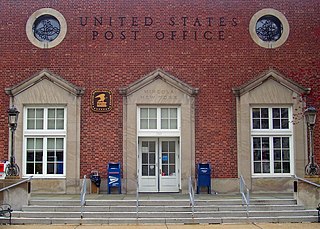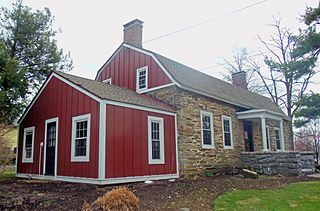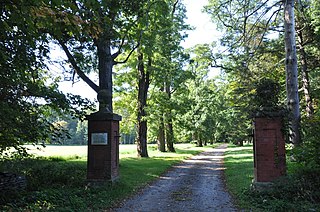
Dutchess County is a county in the U.S. state of New York. As of the 2020 census, the population was 295,911. The county seat is the city of Poughkeepsie. The county was created in 1683, one of New York's first twelve counties, and later organized in 1713. It is located in the Mid-Hudson Region of the Hudson Valley, north of New York City.

Rhinebeck is a village in the town of Rhinebeck in Dutchess County, New York, United States. The population was 2,657 at the 2010 census. It is part of the Poughkeepsie–Newburgh–Middletown, NY Metropolitan Statistical Area as well as the larger New York–Newark–Bridgeport, NY-NJ-CT-PA Combined Statistical Area.

The U.S. Post Office in Beacon, New York, is located on Main Street. It serves the ZIP Code 12508, covering the entire city of Beacon and some of the neighboring areas of the Town of Fishkill. It is a stone structure in the Dutch Colonial Revival architectural style built in the mid-1930s. In 1988 it was listed on the National Register of Historic Places along with many other older post offices in the state.

The U.S. Post Office in Hyde Park, New York, serves the 12538 ZIP Code. It is a stone building in the Dutch Colonial Revival architectural style, located on East Market Street just east of US 9.

Top Cottage, also known as Hill-Top Cottage, in Hyde Park, New York, was a private retreat designed by and for Franklin D. Roosevelt. Built in 1938 to 1939, during Roosevelt's second term as President of the United States, it was designed to accommodate his need for wheelchair accessibility. It was one of the earliest such buildings in the country, and the first significant building designed by a person with a disability.

The Hudson River Historic District, also known as Hudson River Heritage Historic District, is the largest Federally designated district on the mainland of the contiguous United States. It covers an area of 22,205 acres extending inland roughly a mile (1.6 km) from the east bank of the Hudson River between Staatsburg and Germantown in Dutchess and Columbia counties in the U.S. state of New York. This area includes the riverfront sections of the towns of Clermont, Red Hook, Rhinebeck and part of Hyde Park. This strip includes in their entirety the hamlets of Annandale, Barrytown, Rhinecliff and the village of Tivoli. Bard College and two protected areas, Margaret Lewis Norrie State Park and Tivoli Bays Unique Area, are also within the district.

Formerly the Wappingers Falls Village Hall this building now houses the Police Department. It is located at the corner of South Avenue and East Main Street in the village of Wappingers Falls, Dutchess County, New York.

The main U.S. Post Office, Poughkeepsie, New York, USA, is located at the intersection of Market and Mansion Streets downtown. The Post Office serves the 12601 ZIP Code, which covers the city of Poughkeepsie, New York and portions of the Town of Poughkeepsie adjacent to the city. It employs a hundred people and handles 300,000 pieces of mail a day and 10 million a year.

The Rhinebeck Village Historic District is located along US 9 and NY 308 in Rhinebeck, New York, United States. It is an area of 167 acres (68 ha) contains 272 buildings in a variety of architectural styles dating from over 200 years of the settlement's history. It was recognized as a historic district and added to the National Register of Historic Places in 1979 as a cohesive area of preserved historic buildings.

The Wappingers Falls Historic District is in the center of that village in Dutchess County, New York, United States. It is a 90-acre area roughly centered along South Avenue and West Main Street, NY 9D and Wappinger Creek. It includes Mesier Park in the center of the village and many adjacent residential neighborhoods, roughly bounded by Elm, Park, Walker, Market and McKinley streets.

The U.S. Post Office in Mineola, New York serves the ZIP Code 11501, covering that community in the Towns of North Hempstead and Hempstead, New York, United States, the seat of Long Island's Nassau County. It is located on the northeast corner of the junction of First and Main Streets.

The Bergh–Stoutenburgh House is located on U.S. Route 9 opposite Mansion Drive in Hyde Park, New York. It is currently used as a district office by state senator Sue Serino.

Hyde Park Elementary School is located on US 9 in Hyde Park, New York, United States. It served students from kindergarten through fifth grade in the Hyde Park Central Schools.

The Maples is a historic house located on 108 Montgomery Street in Rhinebeck, New York. It was built in the 1830s in the Greek Revival style. Three decades later, its exterior was remodeled, adding decoration in the picturesque mode.

The former Lincoln Park Post Office is a building located in Lincoln Park, Michigan. It now houses the Lincoln Park Historical Museum. It was listed on the National Register of Historic Places in 2004.
Evergreen Lands is a historic home located at Rhinebeck, Dutchess County, New York. It was designed by architect John Russell Pope in the Tudor Revival style. It was built about 1932 and is a one to two story dwelling, asymmetrical, with a steeply pitched slate hipped roof. The first story is built of fieldstone, with stucco and half-timbering above. Also on the property are three contributing sheds and a stone wall. The house was built for Laura Delano, a cousin of President Franklin D. Roosevelt. It was originally intended for use as a caretaker's cottage for a larger house that was never built.

Grasmere is a national historic district and estate located at Rhinebeck, Dutchess County, New York. It was built by Janet Livingston Montgomery, widow of General Richard Montgomery.

Kip-Beekman-Heermance Site is a historic archaeological site located at Rhinebeck, Dutchess County, New York.

Murphy Grist Mill, also known as the Old Mill, is a historic grist mill located at Poughquag, Dutchess County, New York. It was built in 1889, and is a two-story, front-gabled, vernacular frame building with a stone and concrete foundation. It has a one-story, hipped roof porch supported by simple contemporary posts. Also on the property are the contributing ruins of a stone mill dam. During his 1909 campaign for New York State Senate, Franklin Delano Roosevelt gave a political speech from the porch of the mill building. The mill remained in use until about 1940. Franklin Delano Roosevelt Jr. purchased the property in 1949 and the mill was used primarily for storage. During the mid-1980s, it was given to the Town of Beekman and restoration began in 2014.

The Beekman Arms Inn—formerly known as the Traphagen Tavern, Bogardus Tavern and Potter’s Tavern, and currently known as the Beekman Arms and Delamater Inn—is an historic inn located in the village of Rhinebeck, New York. It is within the Rhinebeck Village Historic District, a historic district added to the National Register of Historic Places in 1979 as a cohesive area of preserved historic buildings. The inn claims to be America's oldest continuously operated hotel.






















